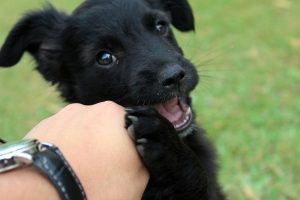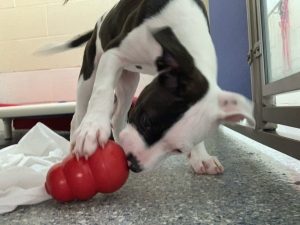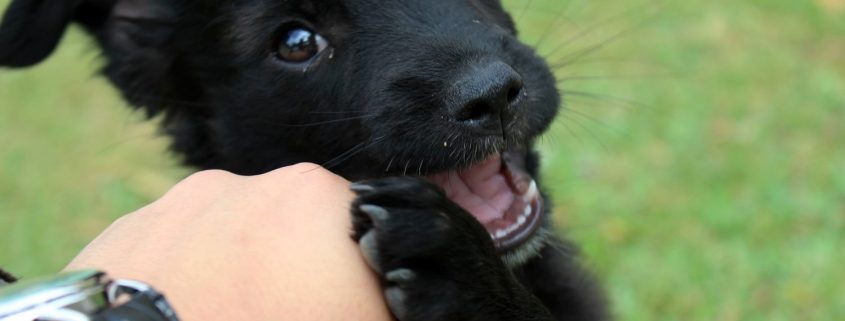Ask Crystal: Chewy 101
Welcome to “Ask Crystal,” where you can ask your pet behavior questions! You can submit your question for Crystal at the bottom of the page!

Dear Crystal,
I have 9-week old puppy who is so gorgeous. But he wants to chew everything in my living room. I don’t want to keep him in the kitchen all the time as he’s part of the family. I know he is a pup so he’s just doing what’s natural but I don’t know how to get him to stop chewing my rug, curtains etc. Can you help?
Sincerely,
Chew Crazy
Dear Chew,
Puppies are like human babies in that they are adorable and everything seems to go in their mouth! Like babies this is how they explore their world. Dogs also chew to ease teething pain. During weeks 3-6 they are developing their deciduous teeth and then at 12 weeks to 6 months they are developing their permanent teeth. The chewing doesn’t simply stop at 6 months though. Chewing behavior tends to continue until the dog is a couple years old. Many dogs will continue to chew on certain favorite objects for the rest of their lives. Chewing is a natural activity for all dogs, young and old. It is how they keep their jaws and teeth in good working order which is pretty important for survival.
Puppies develop chew preferences for things that they are allowed to chew on as puppies. Puppies that are not managed well grow into adult dogs that chew on everything. We must teach them what is appropriate to chew and interrupt inappropriate chewing. Dogs have no way of knowing what is ok to chew on by human standards without guidance. By carefully managing his behavior now while he is a puppy, you are saving yourself a lot of trouble in the future.
There are some other options for managing him beyond leaving him in the kitchen all the time. It is important that he feels like a part of the family. Management means that someone needs to be watching him or he needs to be in a puppy proof location when no one is able to watch him. Freedom to run around the house untethered, unfortunately will likely not be for some time.
When left alone, the puppy should be in some type of puppy proof confinement. Maybe your kitchen is that place for your home. I would suggest a pen inside the kitchen if you aren’t going to use a crate. Kitchens are good in that the floor is tile and easy to clean but I wouldn’t suggest giving him the full run of it. Puppies tend to like to chew on woodwork like doorframes so confining to a smaller, safe location is recommended. Crates work really well for confinement but should only be used for short periods with young puppies. I often suggest a pen around the crate with puppy pads down to give an indoor potty area.
You also need to keep him from running loose around the house when you are home. He should never be out of a person’s sight. Options to keep him in a room with you could be baby gates or pens blocking any openings or using a training tether to attach him to a person, door or piece of furniture. A training tether is simply a leash that you attach to something sturdy. It’s a good option for those with open floor plans. I also like having a large crate in the living room so that I can put my puppy in there for short periods. These management tools are also really helpful for housetraining as well.
You also will need to puppy proof your house. Pick up anything that you care about which could be in his reach. If you leave your shoe somewhere a puppy can reach, that is your fault if it gets chewed up! Put electric cords out of reach or cover them up with PVC or cord covers.
People often ask about chew deterrents like Bitter Apple spray. If you are going to use those, you have to spray it on right before the puppy puts their mouth on the object. That spray tends to wear off quickly. The other issue being that it might not taste that bad to some puppies. It has to be sufficiently deterrent for that particular dog.
 Another part of the puzzle is having a lot of appropriate chew toys. I like to clarify what chew toys are. Often when I ask people what chew toys, they give their dog, they often tell me stuffed animals or squeaky toys. Those are what we refer to as comfort toys. Chew toys are hard and can be made of a variety of materials. They can be natural like bones or manmade like rubber or hard plastic. Dogs need to be supervised while using chew toys. Chew toys should be large enough that they cannot be swallowed and thrown away if pieces come off. I personally like to rotate toys by picking them up and changing the toys my dog has access to periodically. I find that it keeps them interested in a toy if they haven’t seen it in a while.
Another part of the puzzle is having a lot of appropriate chew toys. I like to clarify what chew toys are. Often when I ask people what chew toys, they give their dog, they often tell me stuffed animals or squeaky toys. Those are what we refer to as comfort toys. Chew toys are hard and can be made of a variety of materials. They can be natural like bones or manmade like rubber or hard plastic. Dogs need to be supervised while using chew toys. Chew toys should be large enough that they cannot be swallowed and thrown away if pieces come off. I personally like to rotate toys by picking them up and changing the toys my dog has access to periodically. I find that it keeps them interested in a toy if they haven’t seen it in a while.
When you catch your dog chewing on something inappropriate it is helpful to have some cues as a means of communication to your dog. You can use Leave It to get the dog away from the object. From experience, I know that the puppy will often go back to chewing on the object you told them to leave alone. They don’t immediately understand that it means leave it forever. It just means leave it alone and come over to me. When they come over, you can give them an appropriate toy to redirect them onto. I personally prefer teaching a positive interrupter. This is simply a word that you condition the dog to so that they will come over to you when they hear it. I prefer this because you can choose a happy sounding word or phrase and keep things positive. I use Uh-Oh because it’s hard to say that angrily. I do use Leave It for some things but it is too harsh sounding to use all the time especially in the developing days of your relationship.
Trade is also a valuable skill for your puppy to learn especially when he has something in his mouth that he really wants. Trade is better than simply grabbing things from your puppy’s mouth. Grabbing things can teach him that human hands coming toward him is a negative thing and it can potentially lead to some guarding behaviors. For this reason, I suggest having a supply of amazing treats to trade your dog for stolen objects. To teach this offer your dog a toy by saying “Take it”. When the dog has the toy, hold a handful of smelly treats under his nose and say “Trade” and then give him a few treats in a row when he drops his toy. Play this game often and then practice when he has his own toys or chews. This way you will have a dog happy to drop whatever he has to trade with you.
It can seem like the puppy stage lasts forever but putting in the work now will ensure you will have a dog in the future that understands what things he is allowed to chew. It requires a lot of hypervigilance and patience on your part. The more consistent you are with his training and keeping things positive, the faster the training will go because you will have a relationship built on trust. Happy training!
Until next time,
Crystal







